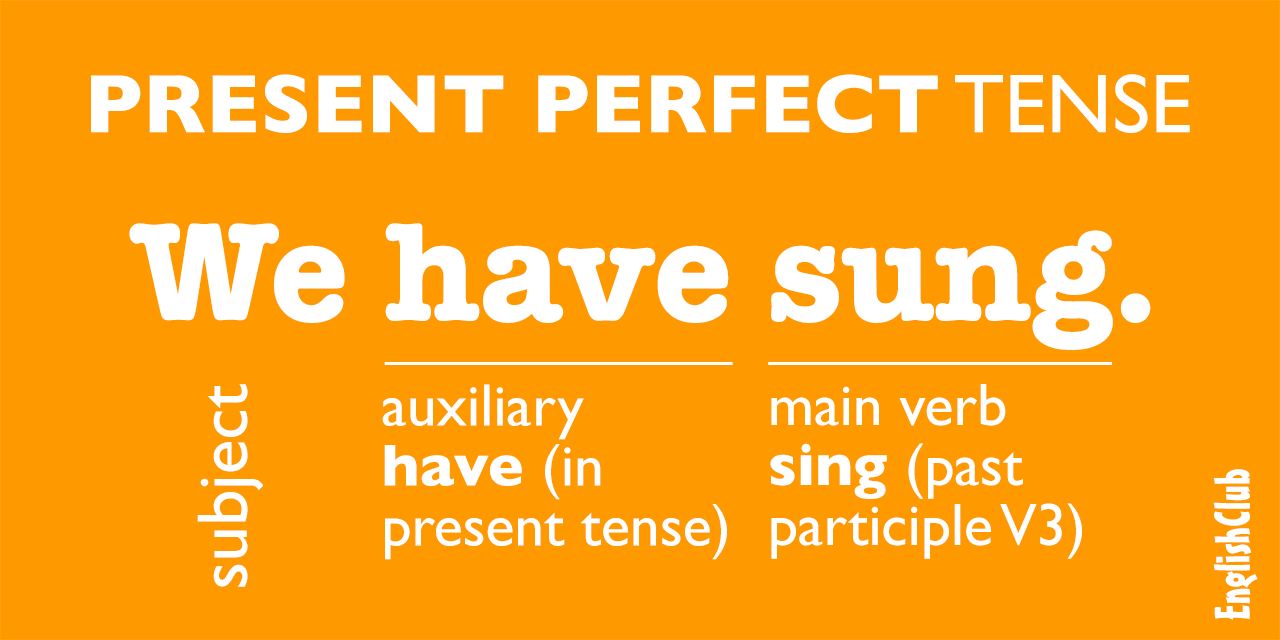
The Present Perfect tense is a rather important tense in English, but it gives speakers of some languages a difficult time. That is because it uses concepts or ideas that do not exist in those languages. In fact, the structure of the Present Perfect is very simple. The problems come with the use of the tense. In addition, there are some differences in usage between British and American English.
In this lesson we look at the structure and use of the Present Perfect tense, as well as the use of for and since, followed by a quiz to check your understanding.

The Present Perfect tense is really a very interesting tense, and a very useful one. Try not to translate the Present Perfect into your language. Just try to accept the concepts of this tense and learn to "think" Present Perfect! You will soon learn to like the Present Perfect tense!
The structure of the Present Perfect is:
| subject | + | auxiliary have | + | main verb |
| conjugated in Present Simple | ||||
| have, has | past participle |
The auxiliary verb (have) is conjugated in the Present Simple: have, has
The main verb is invariable in past participle form: -ed (or irregular)
For negative sentences we insert not between the auxiliary verb and the main verb.
For question sentences, we exchange the subject and the auxiliary verb.
Look at these example sentences with the Present Perfect tense:
| subject | auxiliary verb | main verb | |||
|---|---|---|---|---|---|
| + | I | have | seen | ET. | |
| + | You | have | eaten | mine. | |
| - | She | has | not | been | to Rome. |
| - | We | have | not | played | football. |
| ? | Have | you | finished? | ||
| ? | Have | they | done | it? |
When we use the Present Perfect in speaking, we often contract the subject and auxiliary verb. We also sometimes do this in informal writing.
| I have | I've |
| You have | You've |
| He has She has It has John has The car has | He's She's It's John's The car's |
| We have | We've |
| They have | They've |
In negative sentences, we may contract the auxiliary verb and "not":
This tense is called the Present Perfect tense. There is always a connection with the past and with the present.
We use the Present Perfect to talk about:
We often use the Present Perfect to talk about experience from the past. We are not interested in when you did something. We only want to know if you did it:
Connection with past: the event was in the past
Connection with present: in my head, now, I have a memory of the event; I know something about the event; I have experience of it
We also use the Present Perfect to talk about a change, or new information:
| I have bought a car. | ||
| past | present | future |
| - | + | |
| Last week I didn't have a car. | Now I have a car. | |
| John has broken his leg. | ||
| past | present | future |
| + | - | |
| Yesterday John had a good leg. | Now he has a bad leg. | |
| Has the price gone up? | ||
| past | present | future |
| + | - | |
| Was the price $1.50 yesterday? | Is the price $1.70 today? | |
| The police have arrested the killer. | ||
| past | present | future |
| - | + | |
| Yesterday the killer was free. | Now he is in prison. | |
Connection with past: the past is the opposite of the present
Connection with present: the present is the opposite of the past
Americans do use the Present Perfect but less than British speakers. Americans often use the Past Simple tense instead. An American might say "Did you have lunch?", where a British person would say "Have you had lunch?"
We often use the Present Perfect to talk about a continuing situation. This is a state that started in the past and continues in the present (and will probably continue into the future). This is a situation (not an action). We usually use for or since with this structure.
Connection with past: the situation started in the past.
Connection with present: the situation continues in the present.
We often use for and since with perfect tenses:
| for | since |
| a period of time | a point in past time |
| - - - - - - - - - - - - | - • - - - - - - - - - - |
| 20 minutes | 6.15pm |
| three days | Monday |
| 6 months | January |
| 4 years | 1994 |
| 2 centuries | 1800 |
| a long time | I left school |
| ever | the beginning of time |
| etc | etc |
Look at these example sentences using for and since with the Present Perfect tense:
Contributor: Josef Essberger, founder of EnglishClub.com. Originally from London, England, Josef is the author of several books for learners of English including English Prepositions List and Learn English in 7.
Updated: June 2023"EnglishClub made our classes so fun and informative" - Heloise, Maria Eduarda and Luciano, Brazil
"The Magic site! Cleverly designed, stimulating, easily viewed. Thank you!" - Misha from Belgrade, Learner of English, Serbia
"I am grateful to Josef Essberger for the 7 Secrets. They are informative and sharp." - Andrey Kochanov, Learner of English, Russia